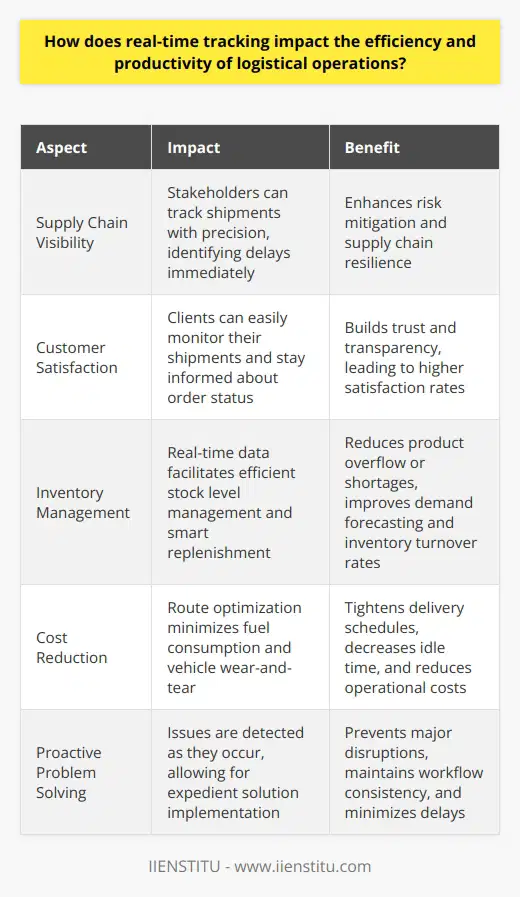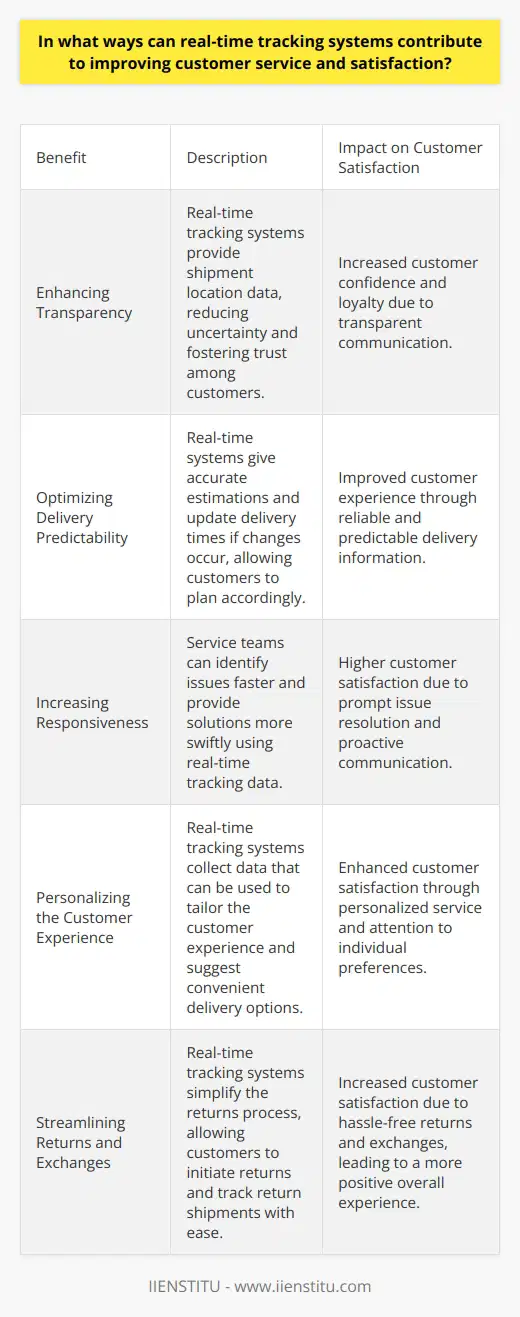Real-time tracking has revolutionized the way we interact with the world around us. This technology allows us to monitor the location and movement of objects or individuals in real time, providing invaluable data and actionable insights across various sectors. From the logistics industry to personal security, the implications of real-time tracking are far-reaching, enabling more efficient operations, enhanced safety, and better decision-making. In this exploration of real-time tracking, we will delve into its mechanics, types, applications, challenges, and future, showcasing its pivotal role in modern society.
Understanding Real-time Tracking
Definition and Conceptualization
The concept of real-time tracking is often taken for granted despite its intricate nature. At its core, real-time tracking is the ability to monitor and report the position and movement of entities instantaneously. However, there is a common misconception that real-time data is always synchronous. In practice, "real-time" may include minor lags due to processing and transmission times, yet it remains sufficiently immediate to be highly useful for decision-making purposes.
History and Development of Real-Time Tracking Systems
The journey of real-time tracking begins with the earliest forms of navigation and has since undergone significant transformations. The ancient methods of location orientation paved the way for more sophisticated systems. One of the pivotal moments in this evolution was the development of the Global Positioning System (GPS), a network of satellites that enabled unprecedented accuracy in position tracking. Over the years, this system has been refined, and augmented by complementary technologies, leading to today's highly advanced real-time tracking systems.
Key Components of Real-Time Tracking Systems
A real-time tracking system primarily comprises hardware devices and software applications. Hardware may include GPS modules, RFID tags, or various sensors capturing positioning data. Meanwhile, the software interprets this data, translating it into user-friendly interfaces and actionable insights. The efficacy of a tracking system hinges on the seamless integration of this hardware and software, ensuring accuracy and reliability of the data provided.
Types of Real-Time Tracking Technologies

Global Positioning System (GPS): GPS stands as the quintessential example of real-time tracking technology. It operates via a constellation of satellites orbiting the Earth that transmit signals to receivers on the ground. These signals are processed to triangulate the precise location of an object. GPS is fundamental in real-time tracking systems used for navigation, logistics, and various other applications that require geolocation data.
Radio Frequency Identification (RFID): Contrary to GPS, RFID technology offers tracking capabilities without the need for a direct line of sight to satellites. RFID utilizes electromagnetic fields to identify and track tags attached to objects. This technology is particularly useful in inventory management and supply chain applications, where items can be effortlessly scanned and monitored as they move through various checkpoints.
Real-time Location System (RTLS): RTLS is a more localized tracking technology that works within a predefined area, such as a warehouse or hospital. It allows for the continuous positioning of entities and is applied through various mediums, such as Wi-Fi, ultrasound, or infrared. RTLS is integral for applications where precise indoor tracking is critical.
Importance and Applications of Real-Time Tracking

In Business Operations: Real-time tracking is transformative in areas such as logistics online course curricula emphasize this technology's importance in teaching supply chain management. It serves a crucial role in optimizing routes, managing delivery schedules, and reducing operational costs. In asset management, real-time tracking helps companies keep tabs on valuable equipment, minimize theft, and streamline asset utilization.
In Public Safety and Law Enforcement: In the sphere of public safety and law enforcement, real-time tracking can be lifesaving. It empowers law enforcement officers to track suspects with higher precision, improving response times and strategic planning. During disasters, real-time tracking facilitates better coordination of rescue and relief efforts, leading to more efficient emergency response and saving lives.
In Healthcare: Healthcare institutions are beginning to harness the power of real-time tracking for enhancing patient care and the management of medical resources. Tracking patients can improve safety and response times to critical situations, while tracking medical equipment helps ensure its availability and proper maintenance, ultimately contributing to better patient outcomes.
In Personal Use: For individuals, real-time tracking offers peace of mind through applications such as child and elderly monitoring, or vehicle and asset tracking. These applications not only provide convenience but also contribute significantly to personal safety and security.
Challenges and Concerns with Real-Time Tracking

Privacy Issues: Despite the myriad of benefits, real-time tracking raises significant concerns over privacy. The intrusive nature of continuous monitoring can lead to apprehensions about personal data security and unauthorized surveillance. As such, the legal landscape surrounding real-time tracking is complex, often struggling to keep pace with technological advancements.
Technical Challenges: Technical issues also present considerable challenges in real-time tracking implementation. Accuracy remains a concern, particularly with technologies that rely on signal strength or require high precision. Furthermore, the effectiveness of tracking systems is often contingent on robust infrastructure – a lacking component in many regions or scenarios, which can severely cripple the system's reliability.
Economic Aspects: Lastly, economic considerations cannot be overlooked. Organizations must weigh the considerable upfront cost of implementing a real-time tracking system against the anticipated efficiency gains and long-term savings. Operating expenses, such as maintenance and software updates, also contribute to the total cost of ownership.
The Future of Real-Time Tracking
Emerging Trends
The future of real-time tracking is intertwined with technological trends such as the integration of Artificial Intelligence (AI) and the expansive reach of the Internet of Things (IoT). AI enhances the way data is processed and decisions made, while IoT expands the ubiquity of tracking capabilities, allowing for an even broader spectrum of applications and smarter systems.
Predicted Advancements
Technological advancements are expected to yield even more sophisticated real-time tracking systems. These may feature enhanced accuracy, better energy efficiency, and greater interoperability among different technologies. Additionally, new potential applications are likely to emerge, pushing the boundaries of what we currently conceive as possible within real-time tracking scenarios.
Conclusion
In this comprehensive exploration of real-time tracking, we have charted the concept's inception, functionality, applications, and prospective future. Real-time tracking has emerged as a cornerstone of modern operations across industries, augmenting safety, efficiency, and informed decision-making. While challenges persist, especially regarding privacy and technology limitations, the forward march of innovation promises to address these concerns. Looking ahead, the integration of AI and IoT alongside other emerging technologies hints at a future where real-time tracking becomes even more pervasive and instrumental in shaping our world.
Frequently Asked Questions
What are the primary benefits provided by real-time tracking systems in supply chain management?
Benefits of Real-Time Tracking in Supply Chain Management
Real-time tracking systems revolutionize supply chain oversight. They offer numerous benefits. Managers can optimize operations with them. Here we explore the primary advantages these systems provide.
Enhanced Visibility and Transparency
These systems offer instantaneous location updates. Stakeholders know where items are. This transparency boosts trust. Customers and partners alike appreciate this visibility. Transparency is fundamental in modern business relationships.
Improved Inventory Management
Inventory accuracy improves. Real-time data helps prevent stockouts. It also avoids overstocking. Companies can thus reduce holding costs. This efficiency translates into savings. Efficient inventory management is critical for profitability.
Streamlined Operations
Real-time tracking facilitates smoother operations. It allows for proactive problem-solving. Issues can be identified and addressed swiftly. Delays decrease significantly. This efficiency reduces downtime. Operations thus become more reliable.
Better Customer Service
Customers receive timely updates. They can plan accordingly. Satisfaction increases as a result. This also enhances the brand reputation. Reliable information supports improved decision-making by customers.
Optimized Routing and Dispatching
Delivery routes can be optimized. Traffic and delays are accounted for. Dispatchers can reroute drivers as necessary. Fuel consumption and driver hours are minimized. These operational efficiencies support sustainability goals.
Enhanced Risk Management
Risks are identified sooner. Mitigation strategies can be deployed rapidly. Financial losses can be reduced. Real-time tracking is a critical risk management tool. It promotes a resilient supply chain.
Data-Driven Decision Making
Data is invaluable in decision making. Real-time insights support strategic decisions. They enable trend identification and forecasting. Businesses can thus adapt to market changes swiftly. Strategic agility is key in today's market.
In conclusion, real-time tracking systems are indispensable. They provide enhanced visibility, improved inventory management, streamlined operations, better customer service, optimized routing, enhanced risk management, and data-driven decision making. These benefits collectively drive supply chain efficiency, risk mitigation, and ultimately business success.

How does real-time tracking impact the efficiency and productivity of logistical operations?
Real-Time Tracking Boosts Logistical Efficiency
Understanding the Role of Real-Time Tracking
Real-time tracking is pivotal in logistics. It allows for instantaneous observation of goods movements. Key stakeholders receive location updates constantly. This enhances decision-making quality. Accurate information leads to superior operational management.
Impact on Supply Chain Visibility
Visibility improves across the entire supply chain. Stakeholders track shipments with precision. Delays are evident immediately. Stakeholders can rectify issues swiftly. Real-time data mitigates risk effectively. It thus bolsters the resilience of supply chains.
Enhancing Customer Satisfaction
Customers expect prompt and accurate deliveries. Real-time tracking facilitates this expectation. Clients monitor their shipments with ease. They stay informed about their order status. Transparency builds trust with the clientele. Customer satisfaction rates naturally soar.
Streamlining Inventory Management
Real-time data aids inventory control. Warehouse operators manage stock levels efficiently. Product overflow or shortages diminish. Integration with inventory systems helps replenish stocks smartly. Demand forecasting becomes more precise. This leads to better inventory turnover rates.
Reducing Costs
Real-time tracking enables cost reductions. Route optimization is a notable benefit. It minimizes fuel consumption. It also reduces vehicle wear-and-tear. Delivery schedules become tighter. Idle time decreases markedly. Fewer resources are wasted. Thus, operational costs decrease.
Improving Delivery Times
Real-time tracking ensures prompt deliveries. Traffic patterns and conditions are known. Alternative routes are chosen instantly. Delivery acceleration becomes possible. Service quality elevates. The market competitiveness of firms improves.
Facilitating Proactive Problem Solving
Issues are detected as they occur. Solutions are then implemented expediently. Real-time alerts prevent major disruptions. The workflow remains consistent. Delays are minimized. The overall process is smoother.
Promoting Accountability
Drivers and carriers remain more accountable. Their performance is monitored closely. Real-time feedback permits immediate correction. Ethical behavior is encouraged. Compliance with regulations improves. Accountability breeds performance enhancement.
Conclusion
Real-time tracking is transformative in logistics. It upscales efficiency and productivity immensely. Key benefits include cost reduction, improved delivery times, and better inventory management. It also empowers proactive problem-solving and enforces accountability. Customers reap the benefits of enhanced service quality. Real-time tracking is not a luxury. It is a necessity for cutting-edge logistical operations. Real-time tracking should be a cornerstone in modern logistics strategies.

In what ways can real-time tracking systems contribute to improving customer service and satisfaction?
Real-Time Tracking and Customer Service
Enhancing Transparency
Customers value transparency. Real-time tracking systems enable this. They provide shipment location data. Customers can access this information easily. It reduces uncertainty. It fosters trust.
Minimizing Information Asymmetry
Real-time tracking reduces information gaps. Customers and companies see the same information. This symmetry limits confusion. It improves communication quality. Real-time data ensures consistent updates. It reduces misinformation.
Optimizing Delivery Predictability
Predictability in delivery is crucial. Customers plan around delivery times. Real-time systems give accurate estimations. They update these times if changes occur. Customers prepare for arrivals accordingly.
Increasing Responsiveness
Service teams must respond quickly. Real-time tracking helps them. They identify issues faster. They then provide solutions more swiftly. This responsiveness increases customer satisfaction.
Reducing Customer Anxiety
Waiting for orders can cause anxiety. Real-time tracking alleviates this. It provides a visual representation of progress. Customers worry less. They feel more in control.
Improving Resource Management
Customers expect prompt service. Real-time tracking assists here. It allows for better vehicle routing. This results in faster delivery times. Efficient routing saves company resources. Customers receive their orders sooner.
Personalizing the Customer Experience
Personalization matters. Real-time tracking systems collect data. This data tailors the experience. It suggests convenient delivery options. Customers appreciate the personal touch. It elevates their overall experience.
Facilitating Proactive Problem-Solving
Problems with deliveries do occur. Real-time tracking can foresee these. It allows for proactive problem-solving. Service can contact customers before they complain. Resolving issues proactively satisfies customers.
Encouraging Feedback
Feedback is essential for service improvement. Tracking systems can prompt feedback once delivery concludes. Real-time insights guide the feedback focus. This direct reflection can drive improvements.
Streamlining Returns and Exchanges
Returns are inevitable. Real-time tracking systems streamline this process. Customers can initiate returns with ease. They can track return shipments as well. Simplified processes leave customers more content.
Fostering Continuous Improvement
Lastly, real-time data fosters improvement. The data highlights service bottlenecks. Companies can then address these problems. Continuous improvement naturally enhances customer satisfaction. It helps maintain competitive service levels.



